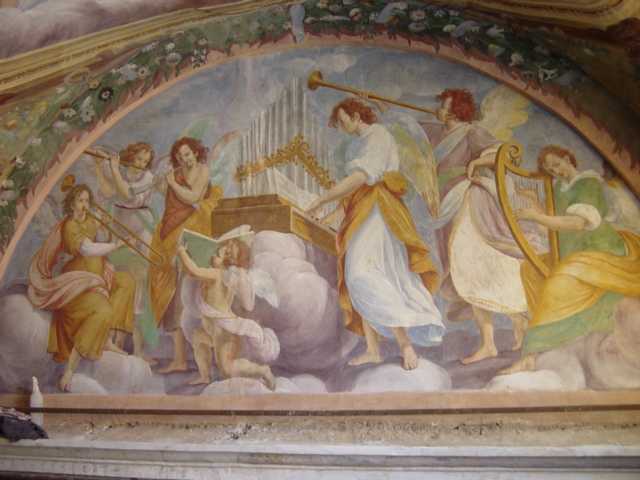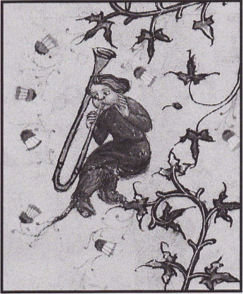Found the below Italian fresco that features a rear-facing (or over-the-shoulder) trombone and added it to the early 17th century timeline. I know of only one other pre-19th century image that clearly shows such an instrument; I’ve included that image in this post as well (1578). Also included at the end of the post (since the entries are in reverse-chronological order) is what is perhaps a proto-rear-facing trombone from c. 1405. The fresco from c. 1615 is also of interest because it has only recently been restored (and, indeed, at the base of the photograph you can see what appear to be some restoration materials left in the picture). Also noteworthy in the painting is the trombone’s bell flare, which is more prominent than usual for this early date. Finally, as I have mentioned several times, it is quite arresting just how many trombone images originate from the 50-year period of 1601-1650.
c. 1615—Cislago, Italy: The Church of Santa Maria della Neve contains an anonymous fresco lunette featuring several angel musicians, including a trombonist. The trombone is particularly noteworthy because it is a rear-facing (sometimes called “over-the-shoulder”) instrument, an unusual configuration for this early date (see below image; public domain) (Morandi; Farioli). For another early rear-facing instrument, see 1578 in the 16th century timeline, where a cherub-trombonist is featured. In later centuries, particularly the 19th century, rear-facing trombones become much more common; the 19th century timeline includes at least 9 such images.
1578—Antwerp, Belgium: A set of masses by George de La Hele includes an image–an initial D in front of a group of cherub musicians–that features a rear-facing trombone being played by a cherub (also rear-facing) (see below image; public domain; Wangermée vol. 1 167). c. 1405—Paris, France: A grotesque from the Hours of Charles the Noble plays what is perhaps a proto-rear-facing trombone; there is no slide, but the similarity in general shape is obvious (see below image; public domain) (RIdIM/RCMI Inventory No. 8, p. 21).
c. 1405—Paris, France: A grotesque from the Hours of Charles the Noble plays what is perhaps a proto-rear-facing trombone; there is no slide, but the similarity in general shape is obvious (see below image; public domain) (RIdIM/RCMI Inventory No. 8, p. 21).